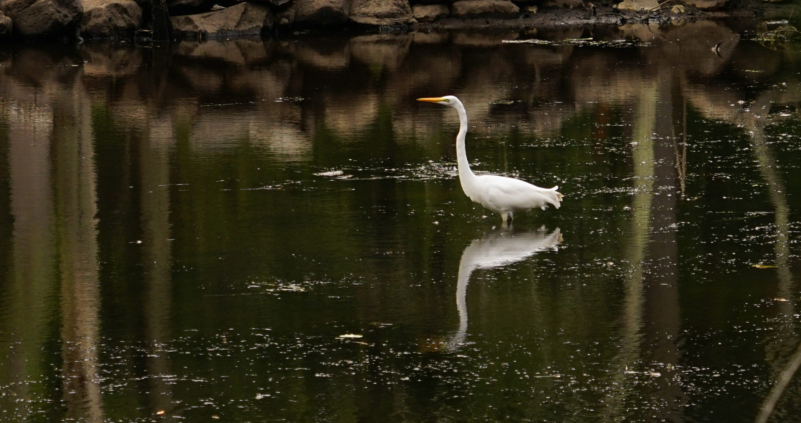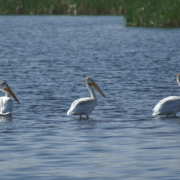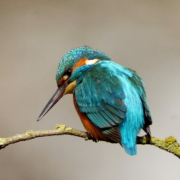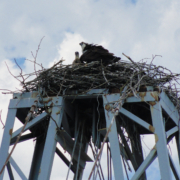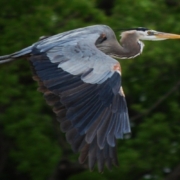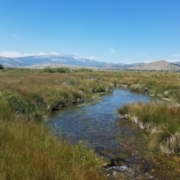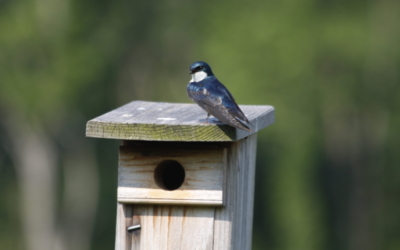AstraZeneca | Engaging Employees to Conserve the Wetlands
Eleven miles east of Boston, Massachusetts lies AstraZeneca’s Waltham site. This facility not only houses pharmaceutical research and development labs, but it’s also the home of the Boston BioHub, an incubator where healthcare start-ups can receive mentoring and support.
Conservation work at the site originally began in 2008 as part of a mandated wetlands replacement project. The Massachusetts Wetlands Protection Act required that the team install buffer zones and maintain the site to preserve the water quality of the neighboring Cambridge Reservoir. However, the AstraZeneca Waltham project team has gone above and beyond these requirements through their use of a Biodiversity Action Plan, the development of living shorelines along the wetlands and the addition of wildflowers and an apiary.
Ultimately, the project team’s goal is to protect and enrich the 10 hectares of wetlands surrounding the Waltham site to boost biodiversity, protect wetland-dependent wildlife and maintain water quality to benefit nearby bodies of water such as the Cambridge Reservoir. The team employs what they call a ‘natural approach to conservation,’ which means they’ve managed the wetland habitat to the point where it essentially maintains itself, while employees continue to protect it from any adverse impacts of the site and monitor the health of the ecosystem.
Maintenance practices reflect this natural approach. AstraZeneca uses an eco-friendly lawn maintenance schedule that allows the grass to grow longer in certain areas, providing key habitat for bees, butterflies and birds. Dead trees are left in place as snags to provide shelter and feeding sites for birds and mammals. When the facility was expanded in 2008, a walking bridge was constructed to connect the new building to the existing one, ensuring that the wetland was not disrupted. By 2009, the facility was in compliance with the required regulations and has continued their maintenance routine since.
Employees at AstraZeneca Waltham are very involved in learning about and helping to monitor the habitat. “Employee engagement and site vibrancy is a key pillar in our business,” said Ginena Harkins, Director of Safety, Health & Environment at AstaZeneca. “We strive to provide our employees with the skills and knowledge to do their part in showcasing the biodiversity on-site.”
In 2021, the project team held a lunch-and-learn event to teach employees about biodiversity and the role of the wetland. The session also included best practices for wildlife photography. Armed with this knowledge, employees were then encouraged to walk the trails, take photos of wildlife and submit them to the project team. The species in these pictures are then identified and used as documentation. To incentivize employee participation, winning photos are chosen and displayed in the main building.
To help employees in this monitoring process, the company provided backpacks full of gear like binoculars, field guides and bug spray. By installing walking bridges and trails, AstraZeneca ensured that employees can safely explore the area without disturbing the habitat. The site is made up of nine different habitat zones including a deciduous woodland, a vernal pond, a long-grass meadow and a brook, with interpretive signage describing each type of habitat as well as the plants and wildlife found there.
At the start of the COVID-19 pandemic, when the site was limited to essential personnel only, the project team shifted their employee engagement tactics. “We had to pivot our thinking to focus on the ways that our employees could consider enhancing biodiversity in their own homes by hosting virtual lunch and learns with master gardeners to provide insights on local plant life that would attract insect and animal species to their homes,” said Harkins. Now that the site is open to staff again, incentives like the photography contest helped employees re-engage in the project.
During the past two years, employees have identified more than 65 animal species and 77 plant species at the site. Especially throughout the pandemic, employees have expressed an appreciation for the green space, which gives them an opportunity to relax and get to know the wildlife around them. “We frequently host nature walks that get our employees out of the building to become immersed in our expansive walking trails,” Harkins said. She explained that this initiative not only gets employees involved in the conservation program, but it also benefits their overall health and well-being by giving them an opportunity to get out into nature.
Related Content:
Blogs:
- Celebrate World Wetlands Day on February 2
- 5 Creative Ways to Reuse Invasive Species
- 6 Ways to Protect Your Local Watershed
- If You Missed Spraying Your Phragmites This Year — What Now?
Webinars:
- All About Monitoring — Capturing Strong Data for Your Certification Application
- Watershed Conservation: Building Partnerships and Securing Funding for Your Projects
- Water Resources Management: Policies, Issues and Voluntary Solutions
- We Need a Buffer: Protecting Wetlands by Installing and Monitoring Riparian Buffer Zones
- The Three “E”s to Success: Employees, Education and Engagement
- Using Employee Education to Strengthen your Volunteer Team: The “Lunch and Learn” Approach
Project Guidances:
White Papers:
- Small Scales, Big Impacts
- Nature-Based Employee Engagement
- Birds: Nature’s Key Performance Indicators
- Reimagining the Corporate Campus
Quick Facts
| Site Name: | AstraZeneca Waltham |
|---|---|
| Category: | Member Spotlight |
| Tag: | wetlands |
| Site Location: | Waltham, Massachusetts |
| Partners: | American Building Maintenance, Cambridge Water Board, Clean Horizons, Groundscape Express, Massachusetts Department of Environmental Protection, Schumaker Landscaping, Solitude Lake Management, Stormwater Compliance LLC, Triumvirate Environmental Inc., Vanasse Hangen Brustlin Inc., Waltham Conservation Commission, Waverly Developmental |
| Project Type: | Wetlands and Water Bodies |
| Certification Since: | 2017 |
| WHC Index Link: | Learn more about the program |
